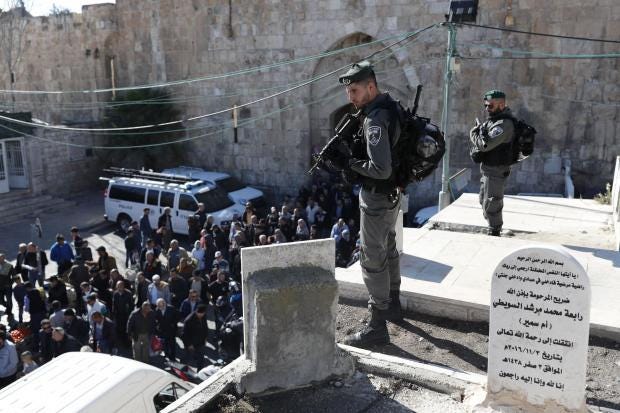All eyes are on Jerusalem’s Old City for anticipated protests in the wake of Donald Trump’s decision to recognise the city as the capital of Israel.
Israelis and Palestinians alike are bracing themselves for a day of rage called for by various Palestinian political groups to protest the US’ move.
On Friday morning the city’s streets were quiet but hundreds of extra police patrolled the city centre in anticipation of protests after midday prayers.
And as people poured out of mosques in the West Bank for planned marches, hundreds of Palestinians clashed with Israeli security forces in the West Bank cities of Hebron, Bethlehem and Ramallah.
Live Updates
Protesters threw stones at Israeli troops who responded with tear gas and rubber bullets.
In Gaza, thousands took to the streets and marched Friday to denounce President Donald Trump's proclamation.
Thousands of Palestinian worshippers also are rallying outside Jerusalem's Al Aqsa Mosque, a flashpoint site in the holy city.
Strikes and demonstrations are expected across Jerusalem and the Palestinian Territories, as well as solidarity protests throughout the region and wider Muslim world, including Malaysia, Indonesia and Pakistan.
More than 50 people were injured in low-level clashes across the West Bank on Thursday. Friday, the Muslim holy day, is usually a bellwether for further violence in the intractable conflict.
The Israeli authorities often impose age limits on access to Jerusalem's al Aqsa mosque barring younger men during periods of increased tensions, but the compound remained open to all on Friday.
Officers would respond to any disruptions, Israeli police said.
The contested city of Jerusalem is claimed by both sides as their capital and control of it is one of the major stumbling blocks to a lasting peace deal in the Arab-Israeli conflict.
Mr Trump broke away with decades of existing US policy and the terms set out in the 1993 Oslo peace accords in his Wednesday announcement that the US would recognise the holy city as Israel’s capital and relocate its embassy there from Tel Aviv.
Though the US administration insisted that the move acknowledges “current reality”, the symbolism has been taken to mean that the US has sided with Israel in the intractable conflict.
The US has been seeking to resurrect talks between Israel and the Palestinians since Mr Trump took office. The president has previously described brokering an end to the Arab-Israeli conflict “the ultimate deal”.
While welcomed by Israeli Prime Minister Benjamin Netanyahu, Palestinian Authority leader Mahmoud Abbas and many other world leaders have expressed concern the controversial move could spark renewed violence in the Middle East and serve as a call to arms for Islamic extremist movements such as Isis and al Qaeda.
Several US allies - including the UK, France and Saudi Arabia - have publicly disagreed with the move.
On Thursday, Hamas’ leader Ismail Haniyeh called on the Palestinian people to rise up in a new intifada.
“We should call for and we should work on launching an intifada in the face of the Zionist enemy,” he said in a speech from Gaza.
“This will not stop until the liberation of Jerusalem and the West Bank,” he added.
Hamas made no mention of utilising its own arsenal to attack Israel, but fears of violence in the volatile region continue to grow.
Observers remain hopeful the relatively low levels of violence seen during protests on Thursday mean Friday will also pass without major incident.
- More about:
- Israel
- Jerusalem
- Palestinian territories
- Donald Trump

